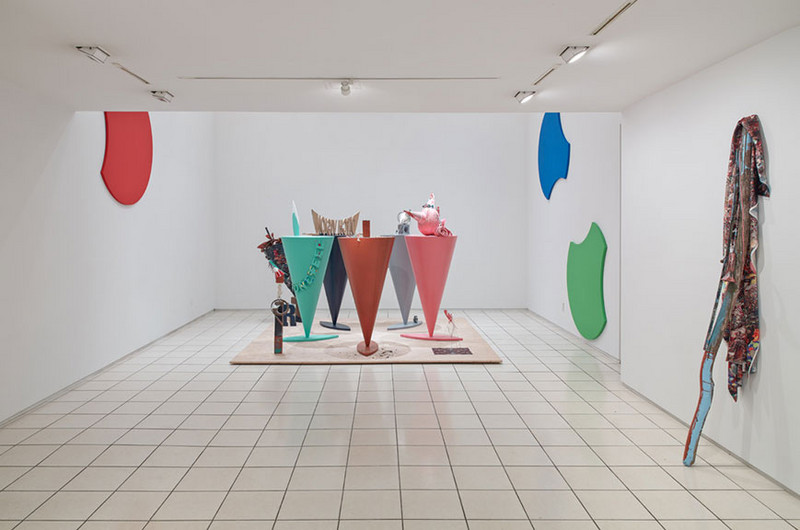Jimmy Raskin
11 Jan - 24 Feb 2013
JIMMY RASKIN
Petals Ears & Tears
11 January – 24 February 2013
Miguel Abreu Gallery is pleased to announce the opening, on Friday, January 11th , of Jimmy Raskin’s Petals Ears & Tears.
In his third one-person exhibition at the gallery, Raskin returns to one of his beautiful obsessions, Arthur Rimbaud’s Vowels (circa 1870), the inspiration of his previous show, Inseparability vs. Simultaneity. In the opening verse of the poem, Rimbaud assigns a color to each of the vowels in the alphabet, “A black, E white, I red, U green, O blue: vowels”. Raskin considers this simple linguistic gesture to be a pivotal point in the history of poetry, the very moment the author acknowledges the arbitrary nature of language. There is a before,and there is an after this event that changes everything...a new world where ‘simultaneity’and ‘infinite juxtaposition’ becomes the norm, the new paradigm of expression, if you will.
For this puzzle of an exhibition, Raskin produced five monochrome, circular panel paintings following the poet’s suggested bright colors. At the initial graphic stage, he overlapped the circles to generate not only the shapes ofa petal, an ear, or a tear, but also a muted mix of five intermediary hues, thus giving himself a palette of maroon, aquamarine, navy blue, gray, and pink, along with a decisive form to work with.
The second major motif structuring the show, the cone, has a long history in Raskin’s visual vocabulary. It first emerged as Pinocchio’s nose in his attempt to resuscitate the dead tightrope walker from the prologue of Friedrich Nietszche’s Thus Spoke Zarathurstra. The tightrope walker was the emblematic figure of the poet, the one focused on the line he performs, devoid of the capacity for critical distance. He was also the subject of the philosopher’s first metaphor as a poet, but had fallen and died. He needed to be brought back to life; the stakes were high in this theater dedicated to the diagnosis of the life of expression. Raskin merged the fallen metaphor with Pinocchio to aid his escape. He went on to name his hybrid character ‘Pinn,’ distilled to a large round head with alarge cone for a nose. The cone later became the focus – the form of memory, instinctand the streamlined shape of intensification itself. The cone’s function here is that of a precarious pedestal, a prop-like sculptural formation made to receive and display what the child might need to make and show. The apparently irresolvable tension between the conceptual dimension of cool design and the glitter of play stays decidedlyactive. The resultingrisk is that one kills the other, but it seems increasingly clear that these opposing forces might simply need one another. If this is indeed the case, the question then becomes one of apprehension, of looking for and finding the proper line of demarcation between the two.
Petals Ears & Tears
11 January – 24 February 2013
Miguel Abreu Gallery is pleased to announce the opening, on Friday, January 11th , of Jimmy Raskin’s Petals Ears & Tears.
In his third one-person exhibition at the gallery, Raskin returns to one of his beautiful obsessions, Arthur Rimbaud’s Vowels (circa 1870), the inspiration of his previous show, Inseparability vs. Simultaneity. In the opening verse of the poem, Rimbaud assigns a color to each of the vowels in the alphabet, “A black, E white, I red, U green, O blue: vowels”. Raskin considers this simple linguistic gesture to be a pivotal point in the history of poetry, the very moment the author acknowledges the arbitrary nature of language. There is a before,and there is an after this event that changes everything...a new world where ‘simultaneity’and ‘infinite juxtaposition’ becomes the norm, the new paradigm of expression, if you will.
For this puzzle of an exhibition, Raskin produced five monochrome, circular panel paintings following the poet’s suggested bright colors. At the initial graphic stage, he overlapped the circles to generate not only the shapes ofa petal, an ear, or a tear, but also a muted mix of five intermediary hues, thus giving himself a palette of maroon, aquamarine, navy blue, gray, and pink, along with a decisive form to work with.
The second major motif structuring the show, the cone, has a long history in Raskin’s visual vocabulary. It first emerged as Pinocchio’s nose in his attempt to resuscitate the dead tightrope walker from the prologue of Friedrich Nietszche’s Thus Spoke Zarathurstra. The tightrope walker was the emblematic figure of the poet, the one focused on the line he performs, devoid of the capacity for critical distance. He was also the subject of the philosopher’s first metaphor as a poet, but had fallen and died. He needed to be brought back to life; the stakes were high in this theater dedicated to the diagnosis of the life of expression. Raskin merged the fallen metaphor with Pinocchio to aid his escape. He went on to name his hybrid character ‘Pinn,’ distilled to a large round head with alarge cone for a nose. The cone later became the focus – the form of memory, instinctand the streamlined shape of intensification itself. The cone’s function here is that of a precarious pedestal, a prop-like sculptural formation made to receive and display what the child might need to make and show. The apparently irresolvable tension between the conceptual dimension of cool design and the glitter of play stays decidedlyactive. The resultingrisk is that one kills the other, but it seems increasingly clear that these opposing forces might simply need one another. If this is indeed the case, the question then becomes one of apprehension, of looking for and finding the proper line of demarcation between the two.

